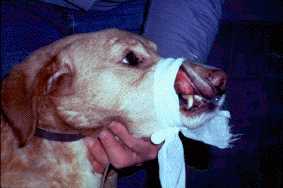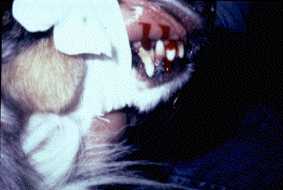I found this in someone external hard disk haha
*****************************************************
A bleeding dog (unknown source)
What is Von Willebrands's disease (vWD)?
Von Willebrand's is an inherited bleeding disorder. In fact, it is the most common inherited bleeding disorder among dogs. The formation of a blood clot is a very complex and involved mechanism. A clot is formed by a cascade of reactions happening in a certain order. For a clot to form, all the factors involved in the cascade must be present and in working order. In Von Willebrand's the factor known as von Willebrand's Factor (vWF) either is not present or is defective. The condition is similar to hemophilia in humans.
What is von Willebrand's factor?
Von Willebrand's factor is a protein complex produced both by platelets (the blood cells involved in clotting) and by the cells lining blood vessels. It is made up of several smaller proteins bound together and von Willebrand's disease results when there is a defect in any one of these proteins. When a blood vessel tears and bleeding occurs, platelets are called to the area to clump upon each other, thus plugging up the hole and staunching the bleeding. While the platelets are in place, a cascade of blood clotting factors activates ultimately leading to production of fibrin, the material scars are made of, to more permanently seal the vessel. Von Willebrand's factor acts as glue holding the platelets together and holds them onto the surface of the torn blood vessel. Von Willebrand's factor also serves to stabilize clotting factor VIII, one of the proteins involved in forming the fibrin clot.When there is something wrong with one's von Willebrand's factor, platelets to do not stick together properly and inappropriate prolonged wound bleeding occurs.
Arrow shows platelets
Why it is called Willebrand's?
Von Willebrand's was discovered in humans and called a "disease" in the 1920s by a Finnish doctor coincidentally named, von Willebrand. Von Willebrand's seldom happens in cats but it is very common in various breeds of dogs.
Causes of Von Willebrand's Disease
Von Willebrand's disease is inherited. This means that it is passed down from parents to offspring.
Breed of dogs predispose to vWD
Certain breeds have a higher incidence of vWD than others. German Shepherds, Doberman Pinschers, Shetland Sheepdogs, Chesapeake Bay Retrievers, German Shorthaired Pointers, Golden Retrievers, Standard Poodles, and Scottish Terriers all have a higher than normal incidence, showing that it can be inherited. In all, some sixty different purebred breeds have been commonly linked to von Willebrand's with the Doberman Pinscher having the highest incidence.
Doberman Pinscher
Types of vWD
There are three types of von Willebrand's disease.
TYPE I
In Type I, all the proteins making up von Willebrand's factor are present but only in very small amounts. This is the type common in the Doberman Pinscher, the Shetland Sheepdog, the German Shepherd Dog, and the Standard Poodle.
It is thought to be an autosomal trait with incomplete dominance. This means offspring may inherit the disorder if either parent carries the gene, but not all offspring will be affected to the same extent. Dogs with type I disease have reduced but measurable levels of Von Willebrand factor (1 to 60 per cent). Animals that inherit the gene for type I vWD from both parents (homozygotes) die before birth or shortly thereafter.
**Although Dobermans are the most commonly affected by von Willebrand's Disease, they usually have the milder forms (type 1)
Shetland sheepdog
TYPE II
In Type II, the larger proteins making up von Willebrand's factor are completely absent, leaving only the smaller proteins to do the job. This creates more severe bleeding episodes and represents the type of von Willebrand's disease usually seen in German Short-Haired and Wire-Haired Pointers.
Type II vWD is very rare. It is an autosomal recessive trait.
Wire-haired pointers
German Short-haired
TYPE III
In Type III, there is simply no von Willebrand's factor at all. This is the most severe form and is usually seen in Scottish Terriers, Chesapeake Bay Retrievers, and Shetland Sheepdogs. Von Willebrand's disease is not limited to the breeds listed here; forms of von Willebrand's disease have been found in over 50 breeds and in cats and humans as well.
Chesapeake Bay Retrievers
Scottish Terrier
Type III vWD is relatively rare. This form is autosomal recessive. Animals are only affected if they inherit the abnormal gene from both parents, who are clinically unaffected carriers. Affected dogs have zero levels of vWF, while carrier parents have 15 to 60 per cent of normal levels.
Clinical signs
In dogs, the most common clinical signs are spontaneous bleeding from the gums or nose, blood in the urine or gastrointestinal tract, or excessive bleeding at the time of surgery. Clinical signs also include epistaxis (nose bleed), prolonged estrus or postpartum bleeding, hematuria, melena, excessive bleeding after toe-nail cutting and sometimes hemorrhaging into body cavities and organs.
As with most diseases symptoms can range from mild, with bleeding times only being extended slightly, to severe, where bleeding cannot be stopped.
Epistaxis (nose bleed) in a dog
Diagnosis
To diagnose von Willebrand's Disease a veterinarian will often conduct a CBC (complete blood count), urinalysis, blood clotting time or a "buccal mucosal" screening time. The buccal mucosal bleeding time uses a test strip that is tied around the maxilla (upper jaw) that then causes engorgement in the folded-back area. Normal blood clotting time is somewhere between 1.5 to 2.6 minutes.
Blood clotting time procedure:
The dog is positioned in sternal or lateral recumbency. The upper lip is everted and secured using a strip of gauze wrapped snugly around the muzzle. The template device (Surgicutt)is placed on the buccal mucosa and triggered as the timer or stopwatch is started. Simplate incisions are made parallel and Surgicutt incision is made perpendicular to the lip margin.

Blood flow from the incision(s) is blotted using filter paper held directly below, but not touching the wounds. The time from triggering the device until blood no longer appears on the paper is recorded as the bleeding time. The muzzle gauze is removed and pressure applied to the wounds until active bleeding ceases. If needed, topical tissue adhesive (cyanoacrylate) can be applied to prevent rebleeding.

Normal Range: Two to four minutes.
Interpretation: Lip bleeding time is expected to be prolonged in patients with severe acquired or inherited platelet dysfunction or severe von Willebrand disease. There is a variable response in dogs with DIC or mild forms of vWD. Dogs with even severe coagulation factor deficiencies usually have normal lip bleeding time.
"Mucosal bleeding time is the best screening test for a potential defect in platelet function, and is prolonged in dogs with a deficiency in vWF. However the test is non-specific for vWD because it is also prolonged in dogs with thrombocytopenia or functional platelet defects. (Bleeding times are normal in animals with warfarin toxicity, hemophilia A or B, or a deficiency of Factor VII.)"
Treatment
There is no cure for Von Willebrand's disease. If a dog is found to have this condition owners should take special precaution to make sure the dog does not injure themselves.
Avoid drugs that are known to inhibit platelet functions. Aspirin is a prime example of one of these drugs. Others include antihistamines, sulfa- or penicillin based antibiotics, Ibuprofen, the tranquilizer phenothiazine, heparin and theophylline.
Veterinarians have found that thyroid supplementation can lower the tendency in some dogs to bleed while raising the level of vWF concentration.There is also a drug called desmopressin acetate DDAVP that can also increase the vWF protein concentration although the response to the drug is variable. It has been shown to raise the concentration in dogs that do not have von Willebrand's disease. The use in these dogs may not be apparent until it is realized it takes a dog to donate blood for a transfusion to another dog.
In case of an emergency or severe trauma, this donated blood is often the only thing that can save the dog's life.
For owners of breeds that are more prone to having von Willebrand's disease, there is a specialized test that can determine the exact amount of the von Willebrand protein that is present in the blood. If the test comes back positive for the disease, it won't necessary help the dog on a daily basis but will come in handy to know if the dog ever requires emergency treatment or undergoes any type of surgery.
Sources: Animal health diagnosis center; Cornell University College of Vet Medicine, vWD Canine Health Foundation, Canine vWD www.essortment.com, Canine vWD www.therealjackrussell.com, vWD, Wendy C. Brooks, DVM, dipAPVB, vWD www.upei.ca




















3 comments:
Hello
Today i am here to about puppy adoption,Most of us would simply love to adopt a cute puppy at one point in time or other, isn't it? And much to our delight, we can find plenty of puppies for adoption avenues waiting to greet us and to provide us with all details that might matter to us a lot.To know more visit-puppies for Adoption
Thanks
Great blog! Thank you for sharing.
Download Indian Doctors Network and be a part revolutionary doctors app.
Nice blog! Great Sharing.
Visit BookMyCME and reserve the seat for your CMEs, medical event within a minute.
Post a Comment